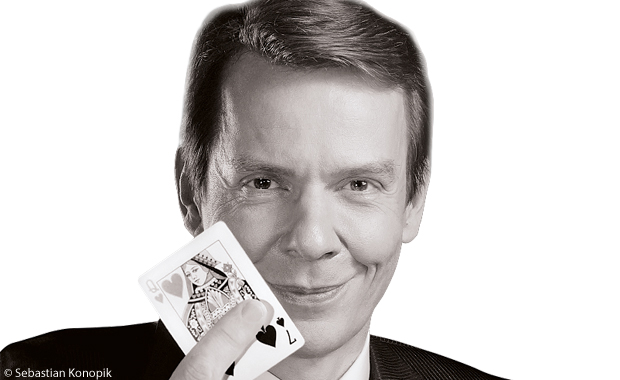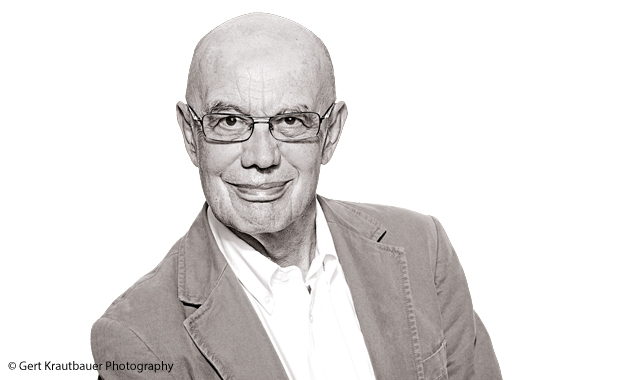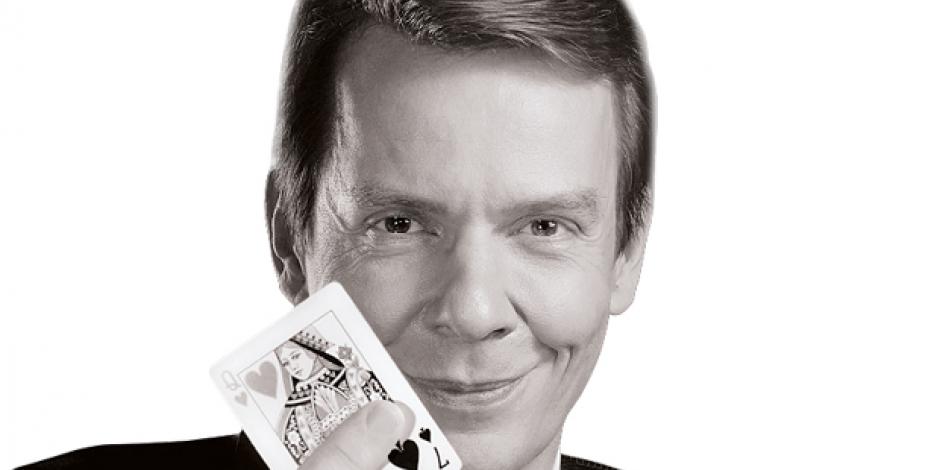Ken Taylor: Jörg, as a professional magicianZauberer/Zauberinmagician, you must be very aware of the importance of involving your audiencePublikumaudience in your show. And I’m sure many of the techniques you use are very relevant to anyone who has to stand up and present in front of an audience.
Jörg Alexander: I agree. stagecraftBühnenkunst, dramaturgisches KönnenStagecraft, like making presentations, involves getting, keeping and directing your audience’s attention — making sure your audience is focused on what you want them to be focused on.
Taylor: Let’s start at the beginning. How do you manage the start of a show?
Alexander: It starts before it starts! I need to be aware of the arrangement of the room and the seating planSitzordnungseating plan. I check whether everyone can see me and whether I can see them.
Taylor: I tell presenters that, whenever possible, they should check out the room and seating arrangements and, if necessary, be prepared to rearrange the furniture so that they feel more comfortable.
Alexander: Right. Then the first few seconds of the show or presentation are very important. How are you going to present yourself? I try to project a positive image with good energy. I smile and make eye contact with everyone in the room.
It’s certainly a magical moment when you first make contact with your audience. It’s perhaps the best magic of the whole magic show!
Taylor: Eye contact is so important. I use the analogy of a lighthouseLeuchtturmlighthouse. I say that you should to sweep sth. with one’s eyesseinen Blick durch etw. schweifen lassensweep the room regularly with your eyes and try to give the audience the feeling you are looking at everyone in the room.
Alexander: It’s certainly a magical moment when you first make contact with your audience. It’s perhaps the best magic of the whole magic show! But I use a different analogy about eye contact. I imagine I’m sending out invisibleunsichtbarinvisible threadFadenthreads to each member of the audience. Then, whenever I look at someone, it’s like to tighten sth.etw. spannentightening the thread and pulling that person in towards me. If I’m not looking at someone, the thread loosens, so I need to retighten it by looking at that person again.
Taylor: I like that analogy. Perhaps I can borrow it for my training!
Alexander: you’re welcome to...du kannst gerne ...You’re welcome to do so. If I’m to be faced with sb.sich jmdm.
gegenübersehenfaced with a tough, sceptical audience, I look for any friendly faces and try to build a positive connection with them. And it’s catchinghier: ansteckendcatching. These positive islands expand to include the people around them. Then, when you are left with one or two “black holes” in the audience, you can use the positive energy that has built up to convince these people to to come on boardetwa: sich anschließencome on board, too.
Taylor: That’s interesting. I sometimes meet sceptical people when I’m training or presenting. And I find that if I can break through the barriers they put up, they often become my biggest allyVerbündete(r)allies for the rest of the time.
Alexander: I find that, too. Another key area in keeping your audience’s attention is storytelling. People love stories. It’s in our genes. It’s how we learn. Magic tricks can have a negative impactWirkungimpact on people. The audience can feel to fool sb.jmdn. in die Irre führenfooled or to cheat sb.jmdn. betrügencheated. So it’s important to build a story around the trick to make it emotionally acceptable.
Taylor: Too many business presenters ignore the power of a good story.
Alexander: Perhaps the first question you should ask yourself when preparing a presentation is: what is the story I want to tell?
Too many business presenters ignore the power of a good story
Taylor: Then the various facts and figures are simply tools for moving the story along. A clear storylineHandlung(sablauf)storyline puts these facts into a context and gives them an emotional hookHaken; hier: Ankerhook.
Alexander: A magician also keeps his audience involved by building in surprises.
Taylor: A business presenter can do this, too. You can show a surprising statistic, or offer a surprising opinion or a surprising solution to a problem. If you do things a bit differently from everyone else, your message is more likely to be remembered.
Alexander: And it’s not just what you say. It’s also how you say it.
Taylor: Too many business presentations sound boring because they are to deliver sth.hier: etw. vortragendelivered in a monotone.
Alexander: It’s all to do with your deliveryhier: Vortragsweisedelivery — the tempo, the use of pauses and the repetition of key memorableerinnerungswürdigmemorable phraseAusdruck, Formulierungphrases. This is so important to me that I go for voice training and singing lessons.
Taylor: Singing lessons?
Alexander: So that I am able to control my voice to get the effect I need.
Taylor: This monotonous delivery often happens when people are working in a foreign language. They are concentrating on finding the words and using correct grammar. They are afraid of making mistakes.
Alexander: I used to be afraid of making mistakes. I thought it would make me lose my status as a magician immediately. But if you have that mindsetEinstellung, Denkweisemindset, that’s when the mistakes happen. In fact, mistakes can often have a positive effect. They make you vulnerableverwundbarvulnerable, human — and people like that. They want you to succeed and will help you if they can.
Taylor: And, anyway, people often don’t notice you have made a mistake unless you tell them!
Alexander: That’s right. So forget your fears, focus on your connection to your audience and communicate!
Taylor: That seems like a very good piece of advice to end with. Jörg, it’s been really interesting finding out the similarities between magicians and presenters. Based on these ideas, let’s hope our readers can to sprinkle sth. on sth.etw. auf etw. streuensprinkle some magic on their next business presentation!

Jörg Alexander is an engineerIngenieur(in)engineer, speaker and magician. After to earn a degreeeinen Abschluss machenearning a degree in engineeringIngenieurwesenengineering, he turned his lifelong passion for the art of magic and illusion into his full-time profession. Apart from his artistic performances, he also works as a keynote speakerHaupt-, Festredner(in)keynote speaker on reality, perceptionWahrnehmungperception and illusion.

Ken Taylor is a communication consultant and personal coach and author of 50 Ways to Improve Your Business English (Summertown). Contact: KTaylor868@aol.com
What’s your challenge?
Would you like to have a conversation with Ken Taylor about your current work challenges? If so, send an email with your name, company and the subject you would like to discuss to business.trainer@spotlight-verlag.de.
In each issue, we will choose one reader who will talk to Ken, and the dialogue will be published in Business Spotlight.
Neugierig auf mehr?
Dann nutzen Sie die Möglichkeit und stellen Sie sich Ihr optimales Abo ganz nach Ihren Wünschen zusammen.



